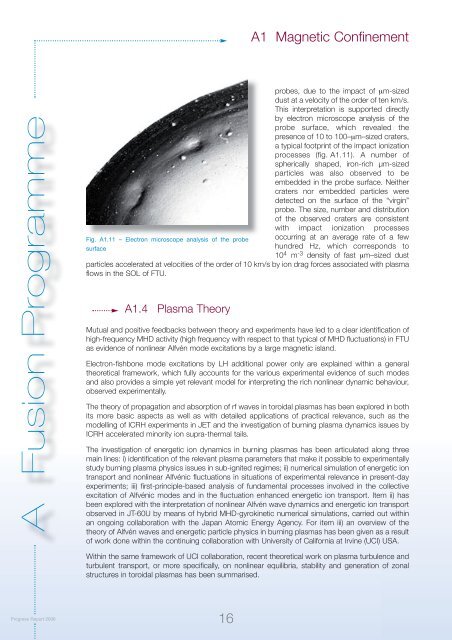PROGRESS REPORT - ENEA - Fusione
PROGRESS REPORT - ENEA - Fusione
PROGRESS REPORT - ENEA - Fusione
You also want an ePaper? Increase the reach of your titles
YUMPU automatically turns print PDFs into web optimized ePapers that Google loves.
A1 Magnetic Confinement<br />
A Fusion Programme<br />
probes, due to the impact of μm-sized<br />
dust at a velocity of the order of ten km/s.<br />
This interpretation is supported directly<br />
by electron microscope analysis of the<br />
probe surface, which revealed the<br />
presence of 10 to 100–μm–sized craters,<br />
a typical footprint of the impact ionization<br />
processes (fig. A1.11). A number of<br />
spherically shaped, iron-rich μm-sized<br />
particles was also observed to be<br />
embedded in the probe surface. Neither<br />
craters nor embedded particles were<br />
detected on the surface of the “virgin”<br />
probe. The size, number and distribution<br />
of the observed craters are consistent<br />
with impact ionization processes<br />
Fig. A1.11 – Electron microscope analysis of the probe occurring at an average rate of a few<br />
surface<br />
hundred Hz, which corresponds to<br />
10 4 m -3 density of fast μm–sized dust<br />
particles accelerated at velocities of the order of 10 km/s by ion drag forces associated with plasma<br />
flows in the SOL of FTU.<br />
A1.4 Plasma Theory<br />
Mutual and positive feedbacks between theory and experiments have led to a clear identification of<br />
high-frequency MHD activity (high frequency with respect to that typical of MHD fluctuations) in FTU<br />
as evidence of nonlinear Alfvén mode excitations by a large magnetic island.<br />
Electron-fishbone mode excitations by LH additional power only are explained within a general<br />
theoretical framework, which fully accounts for the various experimental evidence of such modes<br />
and also provides a simple yet relevant model for interpreting the rich nonlinear dynamic behaviour,<br />
observed experimentally.<br />
The theory of propagation and absorption of rf waves in toroidal plasmas has been explored in both<br />
its more basic aspects as well as with detailed applications of practical relevance, such as the<br />
modelling of ICRH experiments in JET and the investigation of burning plasma dynamics issues by<br />
ICRH accelerated minority ion supra-thermal tails.<br />
The investigation of energetic ion dynamics in burning plasmas has been articulated along three<br />
main lines: i) identification of the relevant plasma parameters that make it possible to experimentally<br />
study burning plasma physics issues in sub-ignited regimes; ii) numerical simulation of energetic ion<br />
transport and nonlinear Alfvénic fluctuations in situations of experimental relevance in present-day<br />
experiments; iii) first-principle-based analysis of fundamental processes involved in the collective<br />
excitation of Alfvénic modes and in the fluctuation enhanced energetic ion transport. Item ii) has<br />
been explored with the interpretation of nonlinear Alfvén wave dynamics and energetic ion transport<br />
observed in JT-60U by means of hybrid MHD-gyrokinetic numerical simulations, carried out within<br />
an ongoing collaboration with the Japan Atomic Energy Agency. For item iii) an overview of the<br />
theory of Alfvén waves and energetic particle physics in burning plasmas has been given as a result<br />
of work done within the continuing collaboration with University of California at Irvine (UCI) USA.<br />
Within the same framework of UCI collaboration, recent theoretical work on plasma turbulence and<br />
turbulent transport, or more specifically, on nonlinear equilibria, stability and generation of zonal<br />
structures in toroidal plasmas has been summarised.<br />
Progress Report 2006<br />
16













